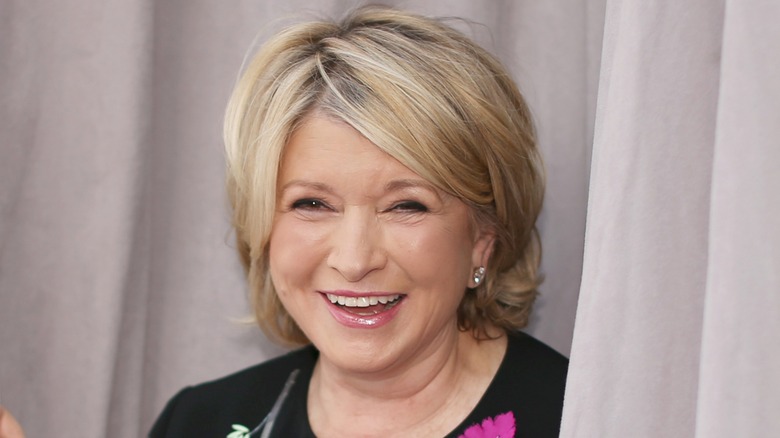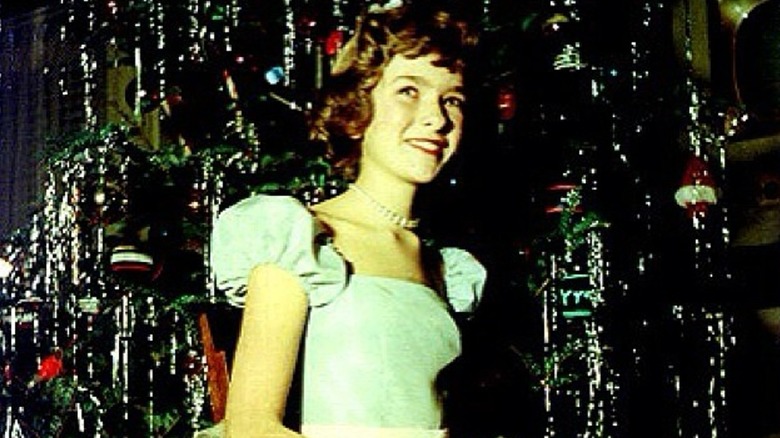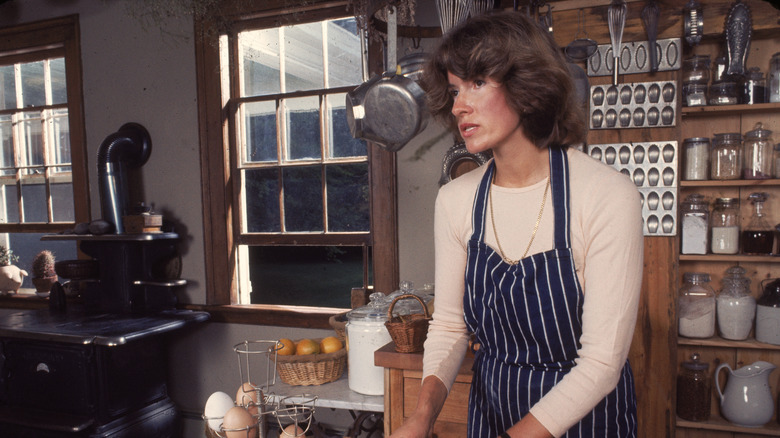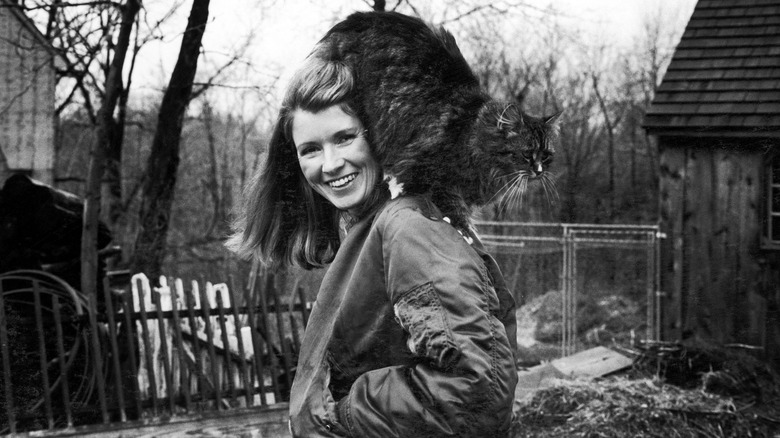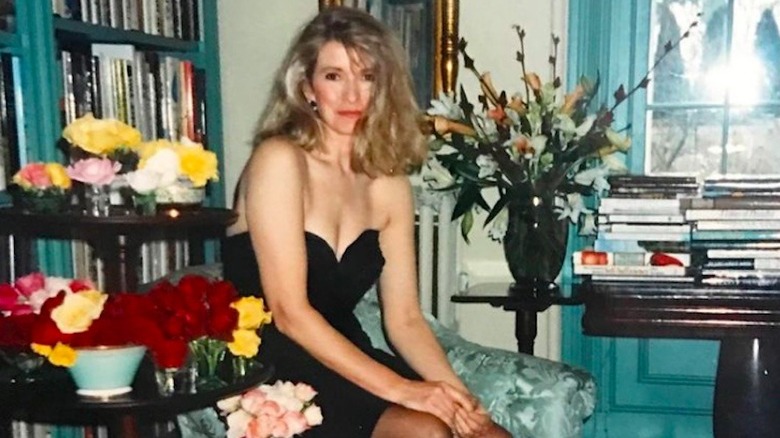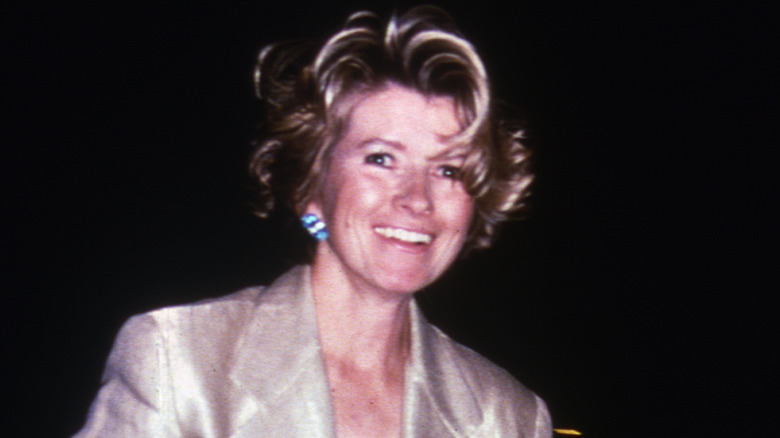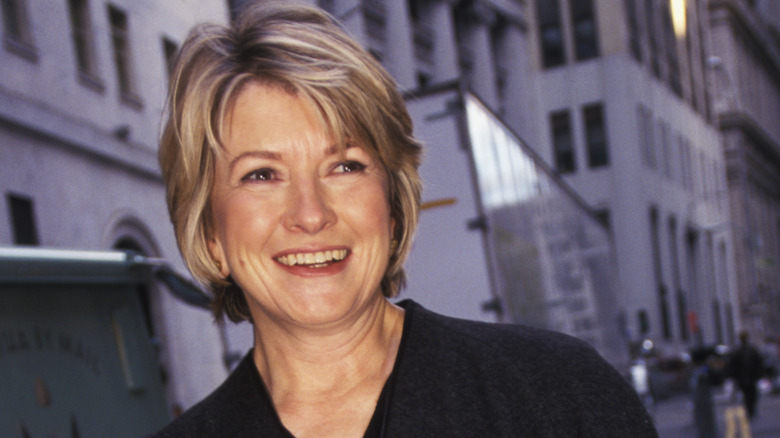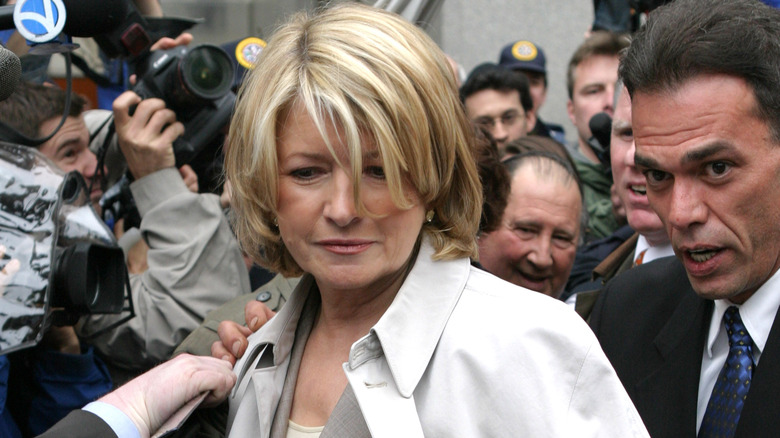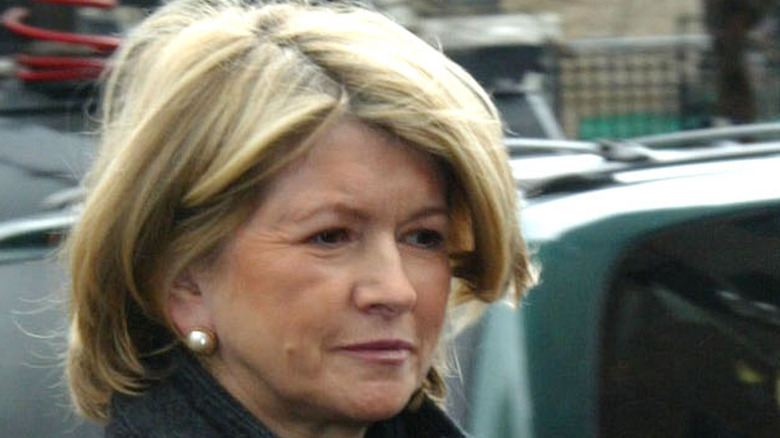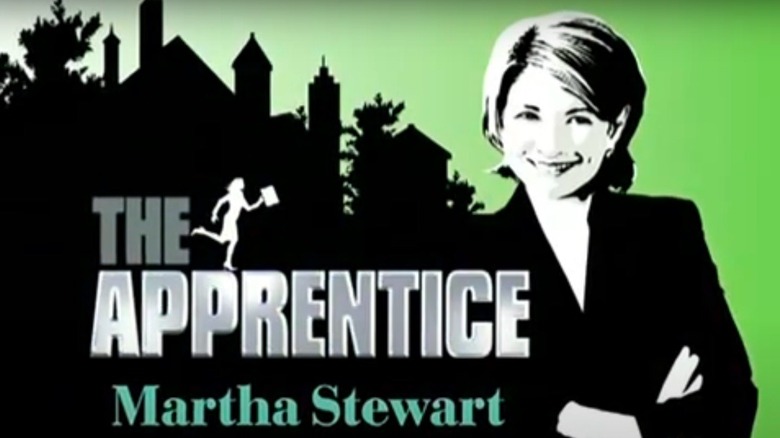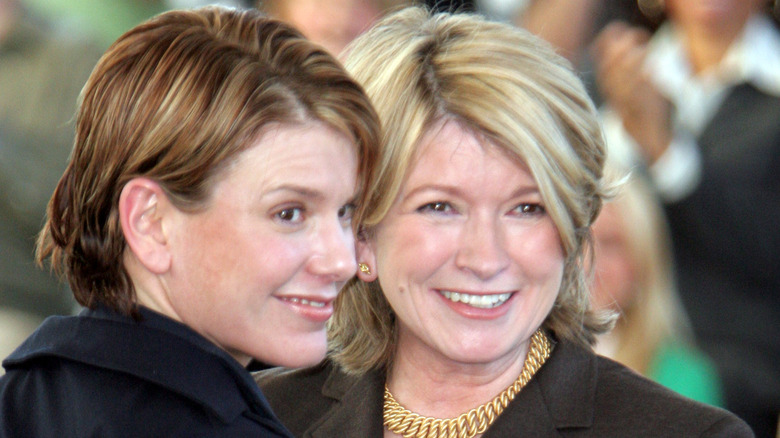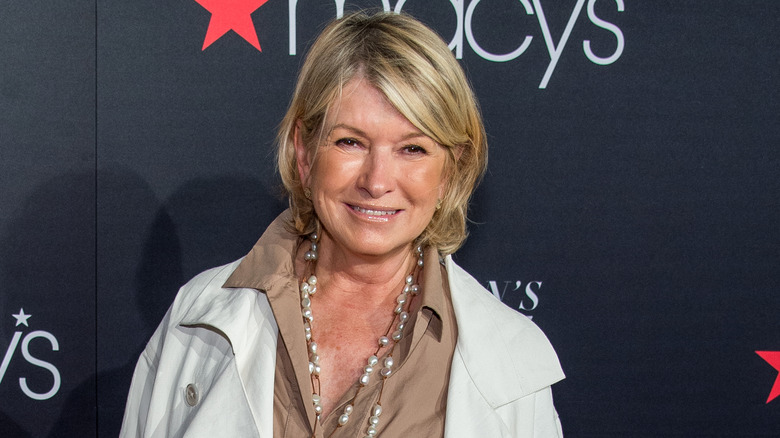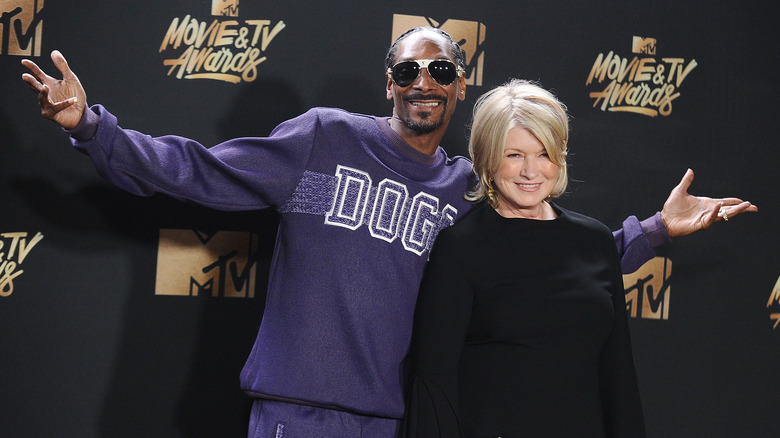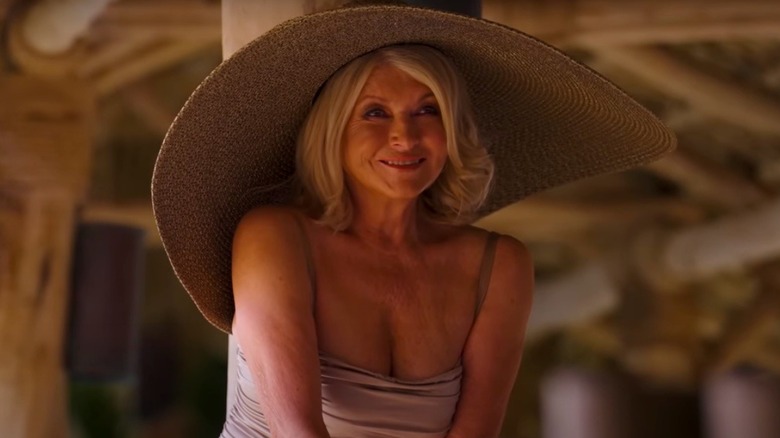The Stunning Transformation Of Martha Stewart From 14 To 82
Throughout her decades in the spotlight, Martha Stewart has managed the rare feat of remaining relevant. Since coming into the public eye in the 1980s, Stewart has demonstrated a chameleon-like gift for peeling away layers to reveal parts of herself that even her staunchest fans were just discovering. "I don't call it reinvention, though," she told People. "I really like to evolve and not be an old-fashioned old lady. I want to know what my limits are but I also want to extend those limits in every way possible."
In fact, Stewart sees her present self not as the result of a series of reinventions, but as an organic evolutionary process — albeit one that's made her one of the most recognizable people on the planet. That, of course, was achieved by some truly masterful branding, with Stewart's name and visage appearing on the cover of her books, magazines, bedding, kitchenware, and a plethora of other products. Then there are her many TV shows and her late-in-life partnership with a beloved rap legend, among other highlights.
Over the years, fans have watched her experience dizzying highs and staggering lows, from her company's historic IPO to her well-documented brush with the law. Through it all, she has remained amazingly consistent in the poise, dignity, and sense of humor with which she approaches both good times and bad. Find out more by reading on to experience the stunning transformation of the brand maven from ages 19 to 82.
Martha Stewart was a teen model before becoming a stockbroker
Born Martha Kostrya (her famous surname came from ex-husband Andrew Stewart) in 1941, Martha Stewart started working as a model when she was just 13. The impetus came from a friend who had been signed by a modeling agency and encouraged her to give it a go. "So I did," Stewart told People. "I signed with Ford Models and was immediately signed up for TV commercials. I was the all-American girl"
After graduating high school, she attended Barnard College in New York City, with history and architectural history as her chosen majors. "Having a formal education was extremely important when I was starting out," Stewart reflected in an essay she published on her website, noting that a college education offered a distinct advantage in the job market, even for those who weren't yet certain what kind of career path they would eventually pursue.
For Stewart, that path led to Wall Street. After graduating, she was hired as an institutional stockbroker at the financial firm, Monness, Williams, & Sidel. Clearly, this was a big departure from modeling, but Stewart thrived in the position. "The job taught me so much about what it takes to build a real business, a real company — a meaningful and useful enterprise," she wrote. Stewart exited Wall Street when she and her then-husband purchased a 19th-century farmhouse in Westport, Connecticut, which would prove to be the setting for an exciting new chapter in her life.
Her life changed when she launched her own catering business
While living at her farm in Connecticut, Martha Stewart became consumed with learning to cook gourmet meals, the more opulent the better. Her guide was the kitchen classic, "Mastering the Art of French Cooking" by Julia Child, which taught her everything she needed to know about the tips, tricks, and techniques that would eventually become her hallmark.
Having dazzled dinner guests on numerous occasions with her culinary creations, in 1973, the ever-entrepreneurial Stewart decided to turn pro. "I started my catering business in my basement," she told the Akron Beacon Journal. It was during this time that she began creating her own recipes and approached every aspect of her burgeoning business with the same degree of seriousness she did when trading stocks on Wall Street. "I think baking cookies is equal to Queen Victoria running an empire," Stewart said in an interview with Oprah Winfrey. "There's no difference in how seriously you take the job, how seriously you approach your whole life."
That strategy proved to be a winning one. As word of mouth about her catering operation spread, she began catering more larger events. It was at one of those soirées that she would have a pivotal encounter that would change her trajectory, taking her to a whole new level beyond anything she had planned. "And that catering business led to a media empire and to a merchandising business," she explained to the Akron Beacon Journal.
Her first book, Entertaining, was a smash hit
In 1977, Martha Stewart was hired to cater a party celebrating the release of a new book. There, she met Alan Mirken, an executive at a publishing company, who saw Stewart's potential. He envisioned a cookbook that would include her self-created recipes and ideas to up the ante when entertaining. "I asked her if she had thought about doing a book, and at that time she wasn't ready," Mirkin said in a 1989 interview with the Sun Sentinel. "But about a year later, she came back with a proposal."
Stewart's first book, "Entertaining," was released in 1982. As Stewart told NPR, she saw a void in the marketplace that she felt she could uniquely fill. "The first book really was kind of an entertaining textbook for the homemaker," Stewart explained. "I couldn't find a good book about entertaining in 1982 and neither could my friend, so I decided to write it."
The cookbook proved to be a massive hit, with more than 625,000 copies snapped up by readers eager to improve their own entertaining. Not only did the book open Stewart's eyes to the possibilities within the world of publishing, but it also proved to be a game changer by expanding her vision. "When I wrote my first book I realized that I do have a voice and the power to encourage others to do good things," she gushed to the Akron Beacon Journal.
She became a lifestyle consultant for Kmart
Kmart was the first retailer to recognize the magic that Martha Stewart possessed, and in 1987, the company hired her to be its spokesperson and entertainment and lifestyle consultant. Stewart became the centerpiece of the retailer's advertising, appearing in several TV commercials and even winding up hawking an array of home-improvement products, ranging from caulking to rust-resistant spray paint.
That partnership continued for years and expanded when Stewart launched her own branded line of linens and towels that were exclusively sold at Kmart stores. While the line was a success with the retailer's customers, it was not a big hit with the snooty members of the Connecticut country club to which she belonged; as she recounted to Harper's Bazaar, her association with Kmart led to her membership being revoked in 1997. "Because I was too downmarket," she explained.
Stewart's deal with Kmart continued successfully for more than two decades until coming to an end in 2009, when she and the retailer ultimately decided to cut ties after being unable to renegotiate their deal. Years later, Stewart revealed that, at one point, her company had the opportunity to purchase Kmart, but executives at her company discouraged the notion. "We thought about buying it, but we didn't do it, and we should have," Stewart told The Associated Press. "That could have been our store — KMartha!"
She launched Martha Stewart Living magazine
After the success of "Entertaining," Martha Stewart continued to churn out more books throughout the remainder of the 1980s, roughly one a year. Subjects ran the gamut, from pies and tarts to wedding planning to hors d'oeuvres. With all that publishing prosperity under her belt, in 1990, she entered the magazine arena with the launch of her own branded periodical, Martha Stewart Living.
"Our families and our homes are the centers of our lives," Stewart wrote in the introductory issue, as recalled in a press release. "This magazine will always be filled with ways to make those homes more beautiful, more comfortable, and more full of life and light and joy for those we love." The magazine was something of a trailblazer in the annals of celebrity branding, in that Stewart was not only its editor in chief, but was also prominently featured within each issue; a template that would be replicated in subsequent celeb-branded magazines featuring the likes of Oprah Winfrey, Rosie O'Donnell, Drew Barrymore, and others.
But Stewart actually didn't own the magazine at first. In 1997, she used the money she had been raking in from Kmart to buy the shares of Martha Stewart Enterprises (which included the magazine) from Time Inc. and formed a new company, Martha Stewart Living Omnimedia. In 2022, Stewart announced that Martha Stewart Living would cease physical publication. However, she promised to keep the party going online, directing readers to follow her to her website.
Her syndicated TV show debuted in 1993
Once her magazine hit newsstands, there was no stopping Martha Stewart. After conquering the world of publishing, in 1993, she set her sights on a whole new medium with the debut of her syndicated daytime TV show. By then, Stewart was no novice to television, having been making regular appearances on NBC's "Today" for some time, and her on-camera skills were sharpened by the time she launched her own show. Sharing the same title as her magazine, the TV show, "Martha Stewart Living," brought Stewart into the homes of millions of viewers. Initially filmed in her Connecticut home, Stewart's on-air program expanded on the themes she tackled in print while introducing her much-parodied catchphrase: "It's a good thing."
In his 1993 review of the series, Entertainment Weekly TV critic Ken Tucker jokingly described some of Stewart's more ambitiously complicated projects — a garden meticulously planted so it would grow in the shape of a knot, for example — writing, "Watching 'Martha Stewart Living' for constructive ideas is like watching 'Beavis and Butt-head' for advice on good manners. As first-class escapism, 'Living' is immensely enjoyable."
Like everything else she had done to that point, "Martha Stewart Living" proved to be a rousing success. Eventually expanding from once a week to five, the show continued to air until concluding its run in 2004. She won the first of her several Daytime Emmy Awards in 1995.
She became America's first self-made female billionaire
In 1999, Martha Stewart made the bold decision to take her company public. In its initial public offering, Martha Stewart Living Omnimedia earned nearly $130 million in its first day on the stock exchange, trading at $18 per share. As the stock price continued to rise, Stewart's 70% ownership resulted in her net worth soaring through the roof and making history in the process. "I was the first self-made female billionaire," Stewart told People.
However, taking the company public was a hard-fought effort for Stewart and was made even more difficult by her gender. "I had opposition, and that kind of opposition to a woman-built business was really outrageous," she said, recalling that even some of her own attorneys were dubious about taking her company public. According to Stewart, the fact that she succeeded laid the groundwork for other women who've experienced similar success in her wake. "I think I helped so many other women believe in their own ideas and their own business plans and their own paths to glory," she explained. "Many other women have built amazing companies and done very well. I think I had a good part in that, without being an overt feminist."
She was accused of insider trading
Martha Stewart's past career as a stockbroker came back to haunt her in 2001 when she was accused of insider trading by the U.S. Securities Exchange Commission. When questioned by the SEC about whether she had made stock trades based on inside information she received from her stockbroker, Peter Bacanovic, both Stewart and Bacanovic allegedly lied to investigators. She was subsequently indicted on fraud charges.
Stewart's brand took a major hit, and the case even impacted her television appearances. That was apparent during an appearance on CBS' "The Early Show" in 2002 to demonstrate how to make some summertime salads. While Stewart chopped vegetables, anchor Jane Clayson grilled her about her legal troubles. "I want to focus on my salad," Stewart icily replied, as reported by Newsweek.
The ensuing trial took place in 2004 and proved to be an absolute media circus. When the dust settled, both Stewart and Bacanovic were found guilty on charges of conspiracy, obstruction, and lying to federal investigators. "I am obviously distressed by the jury's verdict but I continue to take comfort in knowing that I have done nothing wrong and that I have the enduring support of my family and friends," Stewart responded in a statement. "I will appeal the verdict and continue to fight to clear my name. I believe in the fairness of the judicial system and remain confident that I will ultimately prevail." Stewart was ultimately sentenced to serve five months in a federal prison.
She spent five months in a prison nicknamed 'Camp Cupcake'
Rather than wait for her appeal to wind through the courts, Martha Stewart chose to do her time. In September 2004, she reported to Federal Prison Camp Alderson, nicknamed "Camp Cupcake" by the media for its reputation for being, as Business Insider put it, "America's cushiest prison." Her lawyers had advised against jail time, believing it would make her look guilty. For Stewart, however, serving her sentence and getting it over with allowed her to exit the limbo she had been in and finally move on. "My life is my business. My business is my life," she told CNN.
She was released the following March. "I did not allow myself to get depressed," she said during an appearance on the "Late Show with David Letterman" (via CBS News). "I did not allow myself to get down too much. I faced what I had to face." She kept herself occupied with crafts, including making a holiday nativity scene out of clay that she purchased with the monthly stipend she was allotted. "I didn't get a lot of other things that I would have liked in that five-month period because I bought clay instead," she recalled to NPR.
After her release, Stewart was forced to turn down a big opportunity. "My only big regret that I can talk about is that 'Saturday Night Live' asked me to host. My probation officer wouldn't give me the time," she told Harper's Bazaar.
She fell flat with her version of The Apprentice
After her release from the slammer, Martha Stewart unveiled her next TV project: "The Apprentice: Martha Stewart." Following the template of the Donald Trump-starring reality competition, the 2005 series saw Stewart oversee a group of contestants (including a pre-'Real Housewives Bethenny Frankel) charged with tasks that fell within the wheelhouse of her famed lifestyle brand, in areas such as entertaining, home renovation, and more. At the end of the line was a job working with Stewart at her company. With the assistance of two onscreen sidekicks — Stewart's daughter, Alexis, and her company's chairman, Charles Koppelman — Stewart presided over the boardroom as she evaluated the performance of the wannabes. Rather than tell contestants they were fired, Stewart instead sent each person being ejected a sweet note explaining why they hadn't worked out.
As it turned out, Stewart's spin on "The Apprentice" was not very popular with viewers. Reviews were almost unanimously disparaging, as were the dismal ratings, with the heavily hyped series premiere drawing a measly 3.2 million viewers in the all-important 18 to 49 demographic. After completing its run, NBC did not invite Stewart back for another go, with the show being axed after just one season. During a 2015 appearance on "Watch What Happens Live with Andy Cohen," Stewart revealed that the original plan was for her to replace Trump on the original show — until Trump decided he didn't want to leave, resulting in what ultimately proved to be a failed spinoff.
Her daughter wrote a critical tell-all that Stewart found 'hilarious'
In 2011, Martha Stewart's daughter, Alexis Stewart, co-wrote a memoir. Titled "Whateverland: Learning to Live Here," the book didn't exactly paint a flattering portrait of the famed lifestyle guru. According to excerpts published in the Daily Mail, Martha's shortcomings as a mom included forcing Alexis to wrap her own Christmas presents and ignoring Halloween. "There were no costumes," she wrote. "We turned off all the lights and pretended we weren't home." She also griped about never having any prepared food in the house, just ingredients, and portrayed herself as a victim of her mother's notorious perfectionism. "If I didn't do something perfectly, I had to do it again. I grew up with a glue gun pointed at my head," she complained in the book. "Martha does everything better! You can't win!"
Interestingly, Martha responded to her daughter's book with amusement, not anger. "It's irreverent and it's lots of fun," she said during an episode of "The Martha Stewart Show" (via People). "And it is hilarious and it is enlightening and it's full of funny stories." She also addressed some of her daughter's claims, refuting some but confirming she didn't have prepared food in the home. "Yes, if you wanted to eat when she was growing up, you had to cook something. That was the whole idea," said Martha, noting that was why Alexis turned out to be a fabulous cook.
Her lawsuit against competing department stores dragged on for years
In 2011, Martha Stewart Living Omnimedia entered into a 10-year deal with J.C. Penney, which paid $38.5 million for 16.6% ownership in the company and the rights to sell her branded products in its stores. One teensy problem arose, however, regarding an existing contract that Stewart already had with a competing department store chain, Macy's.
Macy's responded by suing both Stewart and J.C. Penney in 2013, claiming the deal she signed with Macy's in 2006 entitled the company to be the exclusive retailer of Stewart's branded wares. "Our company has, in good faith, invested significant sums, taken risks and endured a period of disappointing results in order to rebuild the Martha Stewart brand and grow it in important product categories," Macy's spokesperson Jim Sluzewski posited in a statement to CNN. "JCP is trying to harvest the field planted and cultivated by Macy's."
In response to the litigation, J.C. Penney altered its deal with Stewart, scaling it back to ditch the bed, bath, and kitchen products that Macy's claimed it had the exclusive right to sell, instead limiting its offerings to lighting, rugs, and other items. Macy's characterized the company's move as a "tacit admission" of wrongdoing. In 2014, Stewart and Macy's settled the lawsuit for an undisclosed sum. "Macy's has resolved its breach-of-contract lawsuit against Martha Stewart Living Omnimedia," a Macy's spokesperson said in a statement to CNBC. "We are pleased to be able to put this matter behind us."
Partnering with Snoop Dogg opened up a whole new world
It was back in 2008 that Martha Stewart first welcomed rapper Snoop Dogg to her daytime show. The two clicked, and the following year he made a return appearance. After keeping up with each other on social media, the two reunited in 2015 at the "Comedy Central Roast of Justin Bieber." "She sat next to me, and she stole the show. She was the funniest roaster that night," Snoop said while appearing on "Today." "In that moment I knew I wanted to be alongside this lady for the rest of my life."
After making a few more joint TV appearances, the rapper and the lifestyle maven teamed up officially in 2016 for their own cooking show, "Martha & Snoop's Potluck Dinner Party." Blending Stewart's culinary creativity with celebrity guests — and Snoop's endless stream of marijuana innuendoes — the show ran for two seasons before morphing into a one-season spinoff series, "Martha & Snoop's Potluck Party Challenge."
They reunited once again in 2021 to co-host Animal Planet's Puppy Bowl, with both returning for the 2022 edition. They appeared together in a 2023 shoe commercial, and their partnership has shown no signs of slowing down. "When you work with someone like Snoop, it's like having a sidekick. How great it is," Stewart told People. "That's why all the comedians have sidekicks and bands because it loosens them up and lets them be freer. Snoop is my freedom."
She landed the cover of Sports Illustrated in her 80s
Martha Stewart proved that age is just a number when she appeared on NBC's "Today" in May 2023 to make a big announcement: She was gracing the cover of that year's edition of Sports Illustrated's famous annual swimsuit issue. "To be on the cover at my age was a challenge, and I think I met the challenge," she said proudly.
Upon receiving the invitation to pose for the cover, she was well aware that at the age of 81, she would be making history as the oldest woman ever to model a bathing suit for the magazine. "And I don't think about age very much, but I thought that this is kind of historic," she explained in a video for Sports Illustrated about her photo shoot, which took place on a beach in the Dominican Republic. Her goal, she explained, was to inspire other women her age to feel as if they were also worthy of a swimsuit cover.
While posing for Sports Illustrated as an octogenarian may seem bold and radical, for Stewart it was simply another step in the constantly progressing evolutionary process that's been her life. Asked whether she was rebranding herself while interviewed by The New York Times, she responded, "No, this is part of my ongoing self-creation — I call it education. One of my mottos for many years has been, when you're through changing, you're through."

